Greek island guide: Ten spots even Greek gods would love
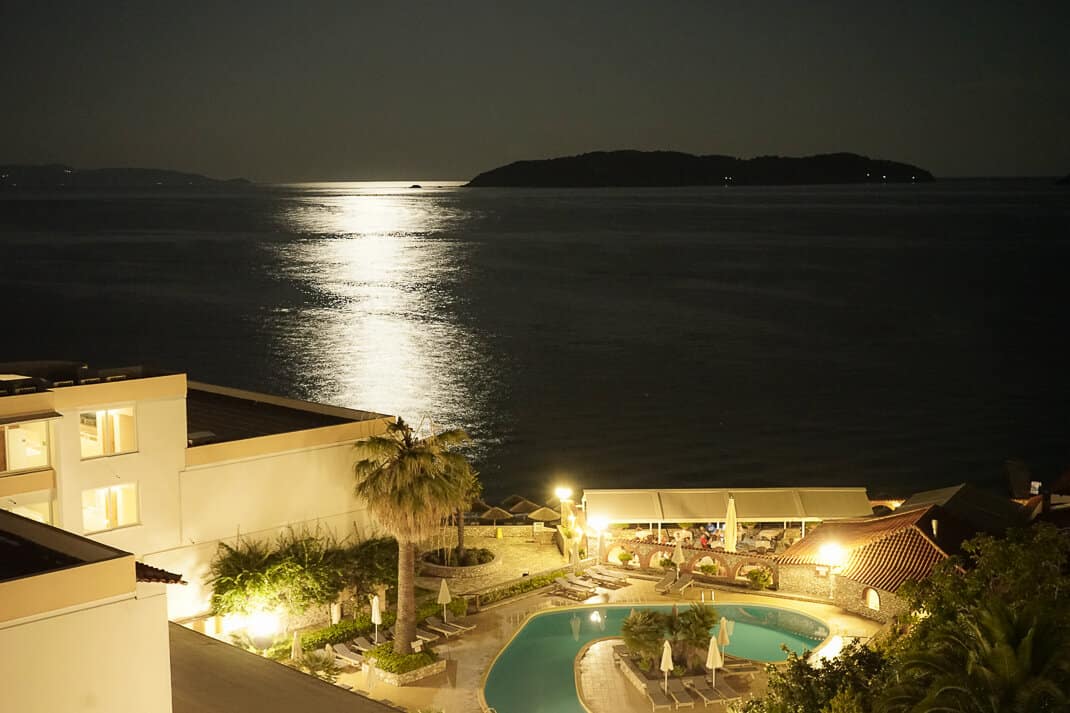
(Director’s note: I’m making my annual trip to Skopelos, Greece, this week. In response to a popular blog I wrote two years ago, I am rerunning my Greek island guide. Not every Greek island is on there. But every Greek island I’ve visited is.)
“You have no idea what freedom is until you wake up and decide what Greek island you want to go to on your way to a boat dock.”
That sage quote didn’t come from Mark Twain or Paul Theroux or any famous travel writer whose observations will remain as long as there is printed paper. It came from another source, someone whose name won’t ring many bells, let alone his quotes.
Me.
I first wrote that during my first visit to Greece in 1978. It’s true. Before moving to Italy, Greece was my favorite country. It has 6,000 islands, each offering unique experiences for those interested in a Greece yacht charter adventure. Each one has its own history, geography and vibe. Add the gorgeous blue seas surrounding them and the luscious, healthy and affordable cuisine and you have an intrepid traveler’s paradise.
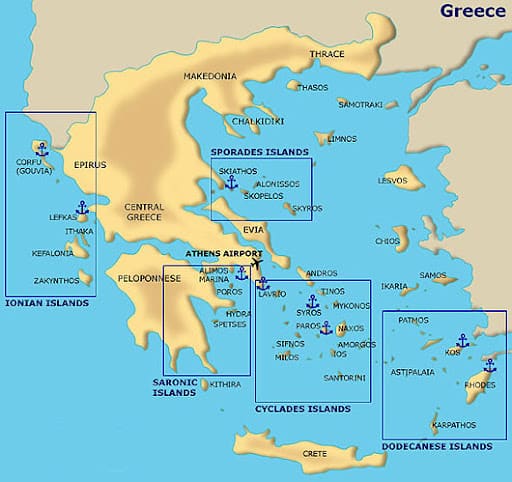
Marina and I go to the isle of Skopelos every August. We leave again Wednesday starting with an extended two-night layover in Athens. It’s perfect timing to share my wisdom of the land which gave mankind democracy, philosophy and ouzo on ice.
I’m far from an expert. Many Americans have been to more Greek islands than U.S. states. I’ve been to 10 Greek islands, a nice even number although a little too heavy to the side of the Sporades island chain. Still, it’s a good brief guide (in alphabetical order with island chain, when warranted, in parentheses). I also added links to articles and blogs where I wrote more in depth.
The summer isn’t over. September is a fantastic time to see Greece. But keep this blog in mind for next year. The islands have been around since the beginning of time.
They aren’t going anywhere.
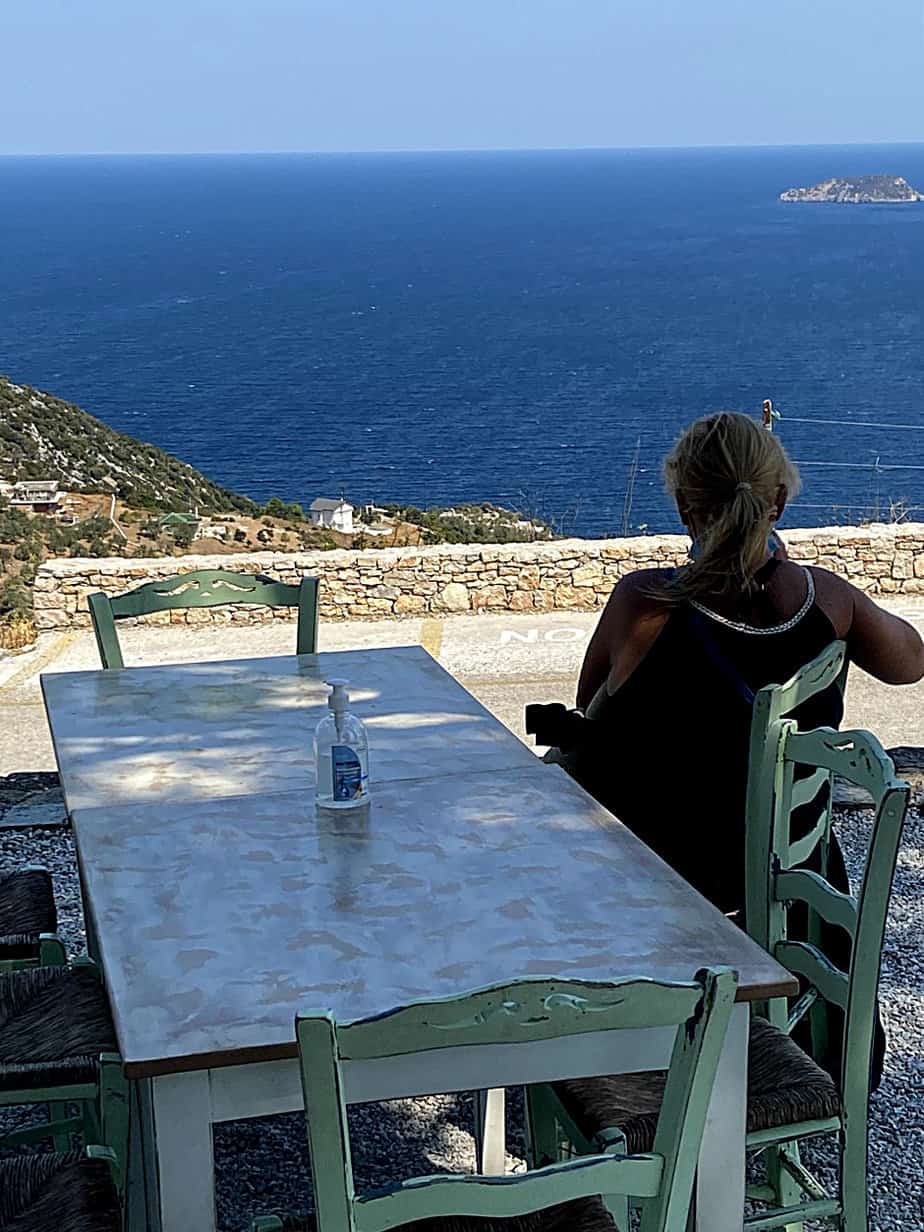
Alonnisos (Sporades)
Marina and I spent a day here on a day trip from Skopelos. It’s only 45 minutes away and the least touristy of the Sporades islands. Thus, come on your own. Don’t go on a package day-trip tour advertised everywhere unless you want 100 strangers to join you.
Alonnisos is a forest mountain. It is covered in pine, oak, fruit and olive trees. The west and north ends are all rocky cliffs with beautiful views but little access to the sea. The east end has little coves and bays with pebble-and-sand beaches.
The island has only two real towns: Patitiri, the main port, and Steni Vala, 11 kilometers to the northeast and surrounded on three sides by water. It’s much more laid back and authentic than Patitiri which has the usual clutter of travel agents and shops.
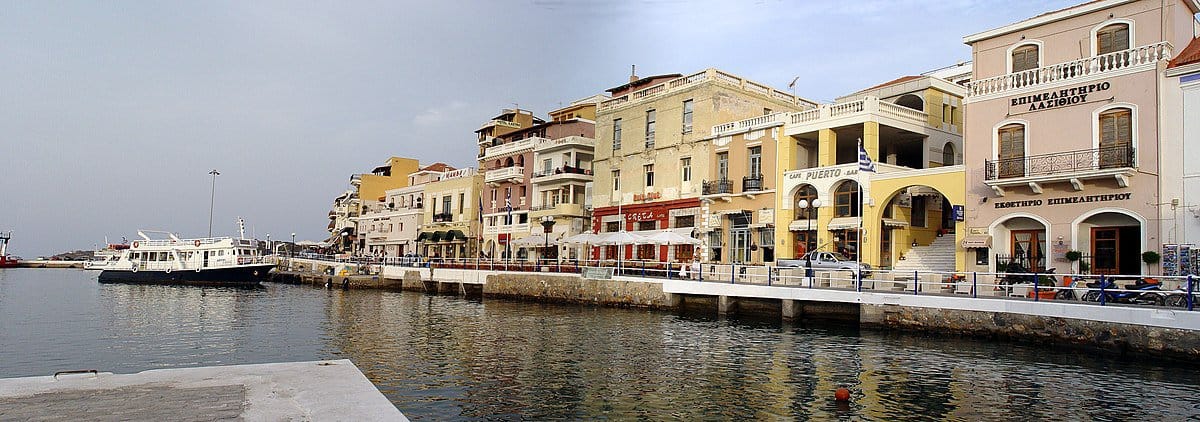
Crete
Crete is large enough to be its own separate island group. It’s about 50 percent larger than Delaware and so geographically diverse. I spent a week sleeping on the beach of Paleochora on the southwest coast and many long, rainy November days playing backgammon with old Greek men in the charming capital of Hania.
Crete’s biggest draw, besides its beaches, is Samaria Gorge. It’s Europe’s longest gorge at 10 miles (16 kilometers) and offers hikes for every level. You just can’t camp inside it so take day trips or hike the whole thing.
Don’t miss the Palace of Knossos, the capital of the Minoan people who date back to the Bronze Age from 3100-1100 B.C. It’s five kilometers south of the town of Iraklio and the ruins include private apartments, baths and frescoes.
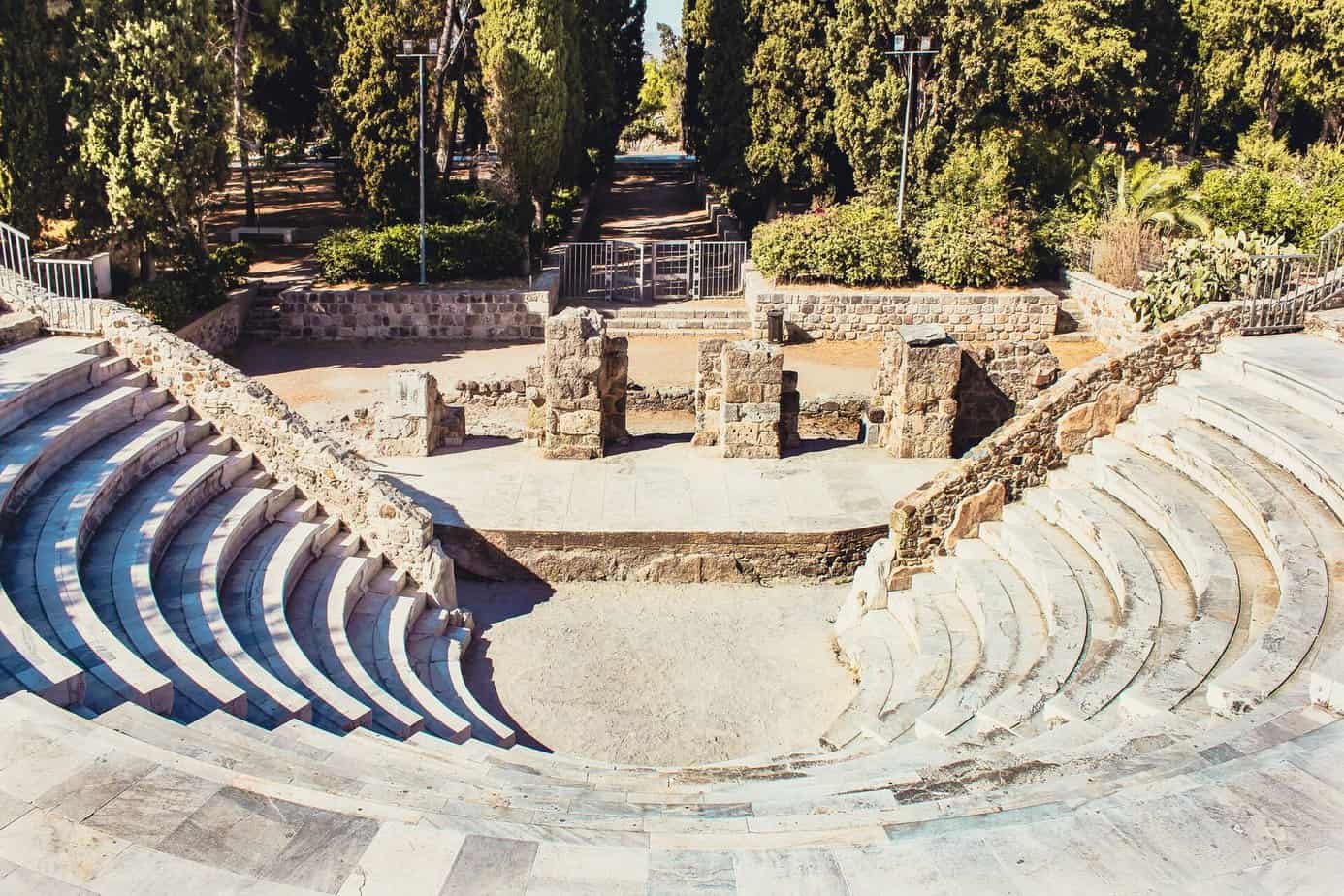
Kos (Dodecanese)
Like to party? Come to Kos. I spent a week here in an alcoholic fog. Except for a loud argument with a South African Airlines flight attendant about how much she misses apartheid, it was one of my best times in Greece.
It has the best beaches in the Dodecanese, the chain closest to Turkey. You need public buses from Kos Town to the best beaches: Mastihari on the north end and Kamari on the southwest. Everywhere you turn you’ll find ancient Greek ruins.
The party scene is concentrated in Kos Town along two streets a block south of the harbor and along the waterfront on Kritika Beach. This is where I met a group of wild Irish women with whom I wound up dancing naked in the Aegean Sea in the wee hours. And I don’t even like to dance.
When the sun came up we all went to a local bakery to eat fresh, warm, homemade bread with butter.
I did spend one sober afternoon under the plane tree where Hippocrates, a Kos native, wrote the Hippocratic Oath in the 5th century B.C.
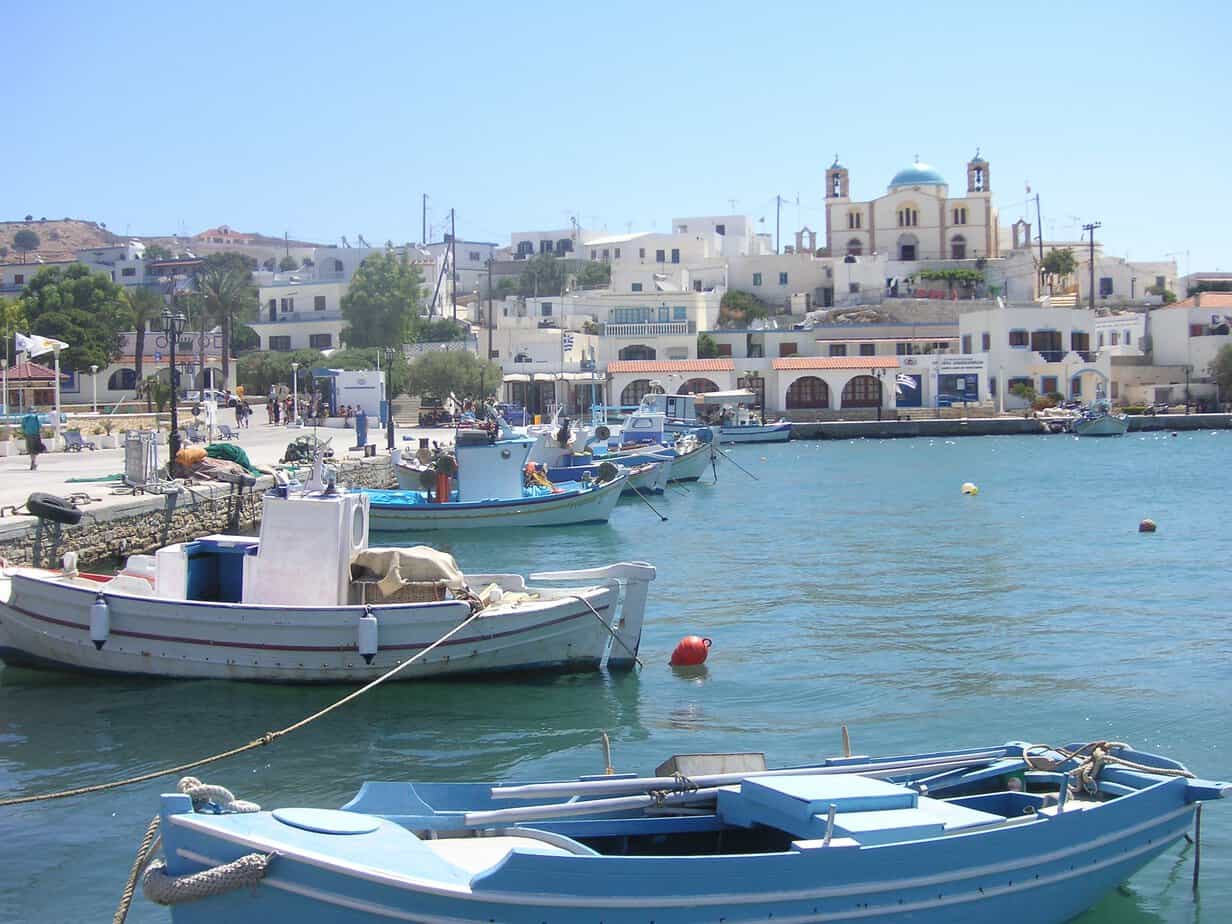
Lipsi (Dodecanese)
As I wrote in a story for the Los Angeles Times, “I’m sitting on a boat dock looking at Greece circa 1950. Jackie Kennedy hadn’t started dating Greek yacht owners.” Lipsi has no airport, no cruise ships, barely much tourism. It’s only 12 square miles where its 800 inhabitants all live in Lipsi Village. It has twice as many donkeys.
Besides 45 churches, it also has 12 isolated beaches, all seemingly on half-moon bays with crystal clear water and hardly any sunbathers. One reason: All the beaches, except Lendou by Lipsi Town, are rocks. However, the rocks are so many and so even and flat, I didn’t find them uncomfortable. And the lack of sand made the sea the clearest I’ve seen in Greece.
It has a cute little town square with excellent tavernas on the small roads leading to it. The people are friendly and I met numerous American and European expats who spent half the year there and hoped Lipsi remained a secret.
Nothing is far away. The farthest beach from Lipsi Town is only a half hour walk and local drivers often asked if I wanted a ride when they spotted me walking along the side of the road.
Check out The Rock, a very good ouzeria overlooking the harbor.
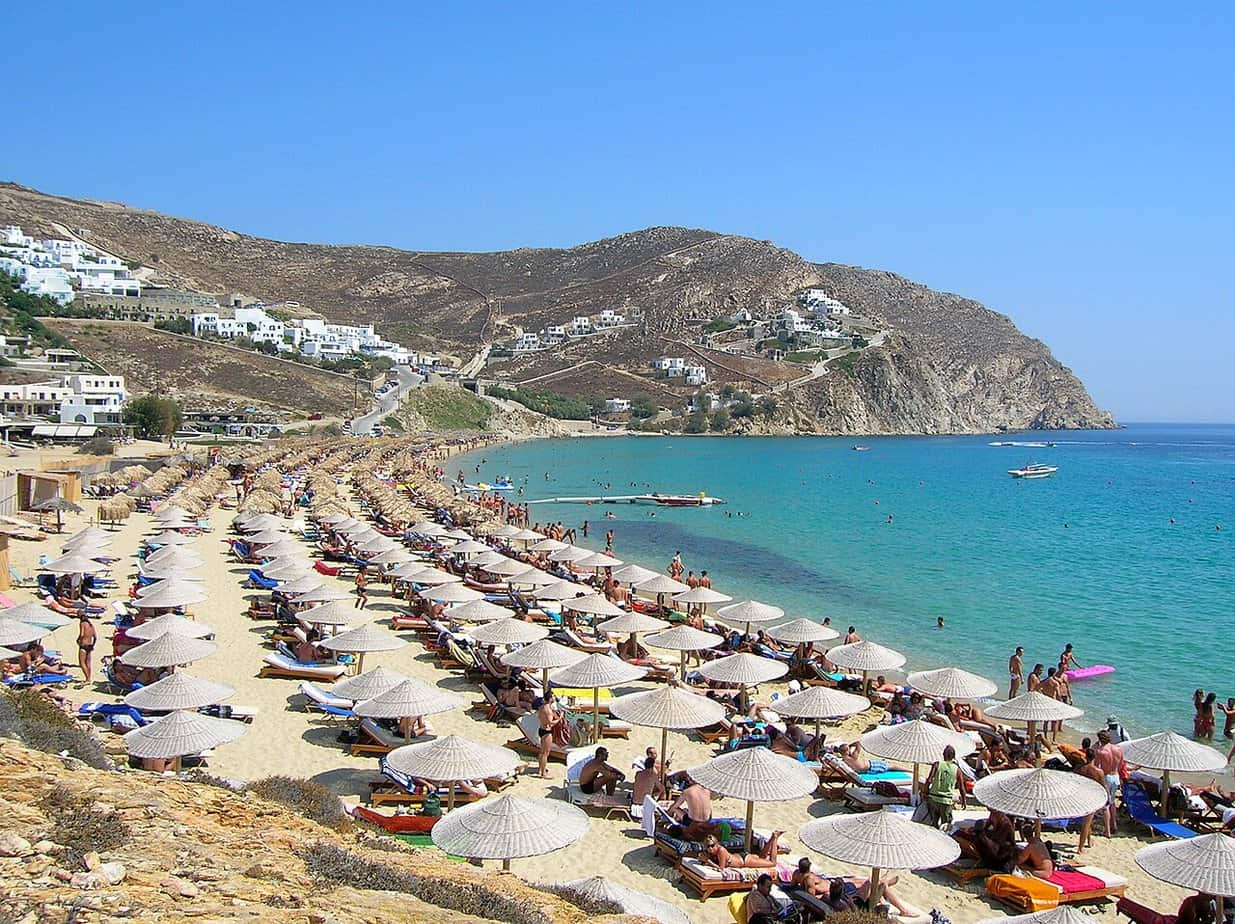
Mykonos (Cyclades)
On the other end of the party spectrum from Lipsi is Mykonos. I came here as part of a three-week island-hopping trip through the tourist-heavy Cyclades. You won’t get away from it all in Mykonos, but you can certainly see it all.
It was party heavy and gay heavy and heavily segregated between gay and straight. I had to walk through the outrageously gay Super Paradise beach to reach my straight beach, averting my eyes while passing naked men giving each other full-body massages.
But the beaches are great, featuring fine white sand that stretches forever. Despite the overtourism that has plagued Mykonos for decades, the natives remained friendly. I ordered an ouzo at the taverna next to my guesthouse and the owner brought me a whole bottle. When I told him I only wanted a shot, he wrote my name down and brought it to my table every day I dined there.
The nightlife goes on all night and is divided into straight and gay bars and clubs. Everyone co-existed and no one openly made fun of the old gay men walking their little poodles along the dock.
Beware of cruise ships disgorging wild, thirsty day trippers and overpriced, touristy restaurants.
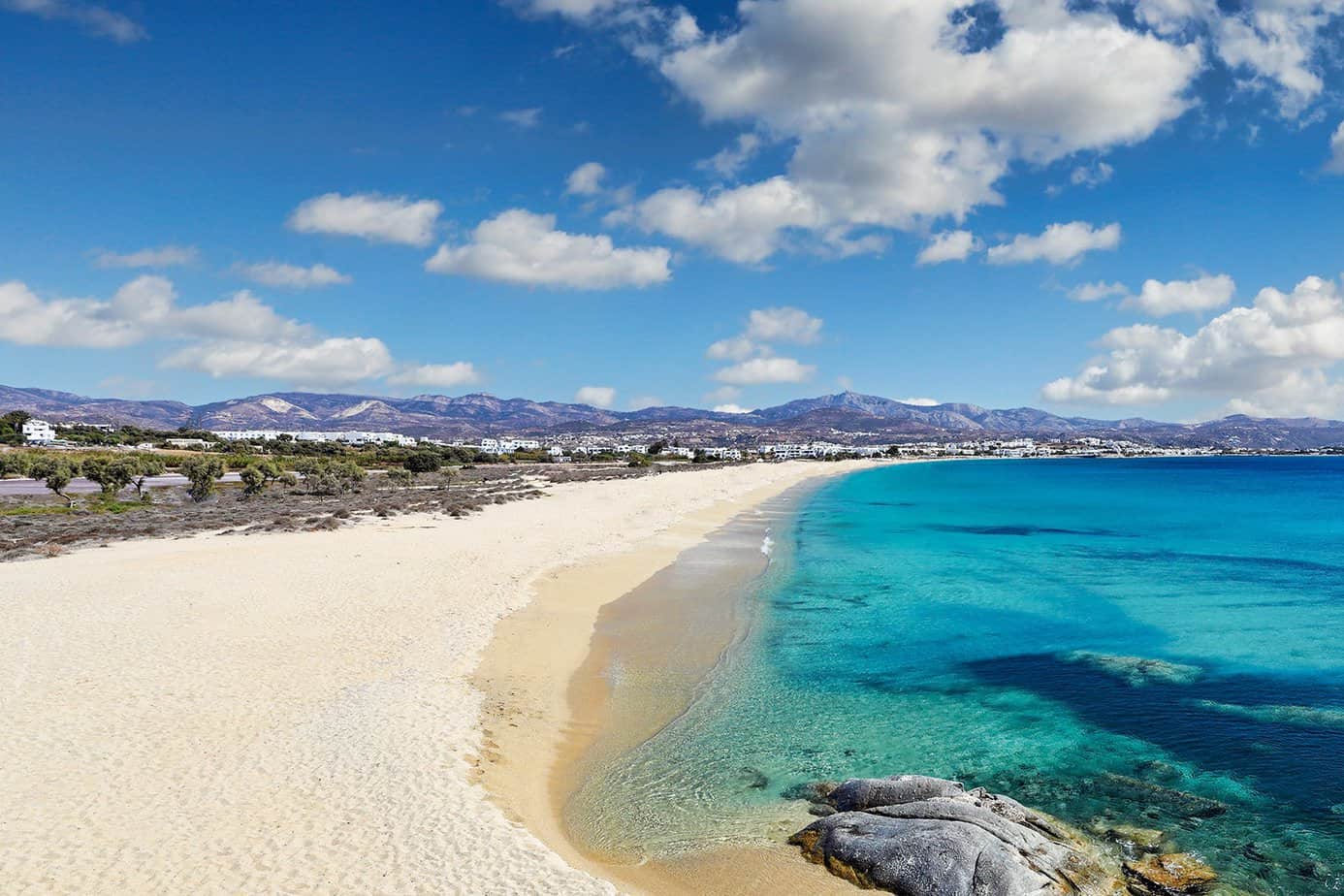
Naxos (Cyclades)
I came here on the same trip and enjoyed it much more than Mykonos. Naxos, part of the Venetian Republic for 300 years, is where Europeans come to play. I didn’t see another American. The beaches are big and sandy and not nearly as crowded as its Cyclades sisters, Mykonos and Santorini.
At 166 square miles, Naxos is the biggest of the Cyclades, offering much bigger variety. Besides the isolated beaches, it has high mountains (topped by 1,004-meter Mt. Zeus. Honest. It’s called Mt. Zeus) that provide romantic morning clouds hovering over the quaint mountain villages. It’s where you find men who’ve lived here for generations playing backgammon on taverna porches. Check out the villages of Halki and Apiranthos.
The main town of Hora is hilly and fun to explore through the windy alleys in the old town. The Venetians made Hora the heart of the Duchy of the Aegean and the old town’s layout hasn’t changed since. Search for Kastro, the 13th century residential neighborhood which was the capital of the Duchy. Venetian mansions can still be seen as well as the Tower of Sanoudos, the remains of the Venetian castle.
Kastro is also a good place to drink with good views from upstairs bars. Go to the south end of the waterfront for rowdy clubs.
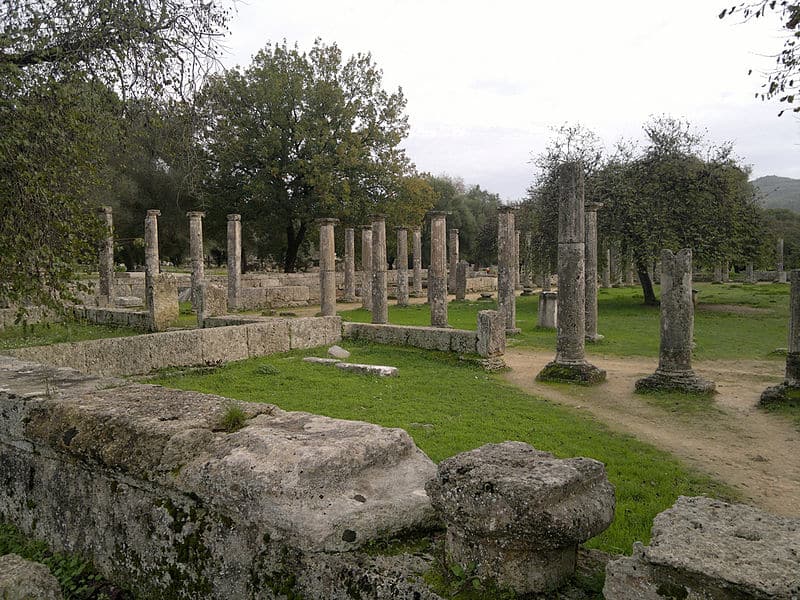
Peloponnese
Is Peloponnese really an island? It’s almost the size of New Jersey. Yes, it’s an island. It’s surrounded by water on Greece’s southwest end and connected to the mainland only over the Corinth Canal to the east and over the Rion-Antirion Bridge to the north.
It’s a two-hour drive from Athens which I took as part of a series of stories I wrote before the 2004 Olympics in Athens. Peloponnese is where the Ancient Olympics were held from the 8th century B.C., to the 4th century A.D. in the town of Olympia. The site had 760 buildings in what is now the town of Elis. Many of the buildings still exist.
Part of the stadium can be toured, complete with starting stations for sprints. I took the obligatory photo of me in the starting blocks with my sportswriting colleagues. There is also remains of a gym where they held wrestling.
This is still where the Olympic flame leaves on its worldwide tour to each Olympics’ Opening Ceremony. It was also the site of the shot put competition during the 2004 Olympics.
If you’re not a sports fan, visit Nafplio, a beautiful seaside village that was Greece’s capital before Athens. It still features picturesque alleys and elegant houses. Go to Palamidi Fortress for panoramic views of the coast and sea.
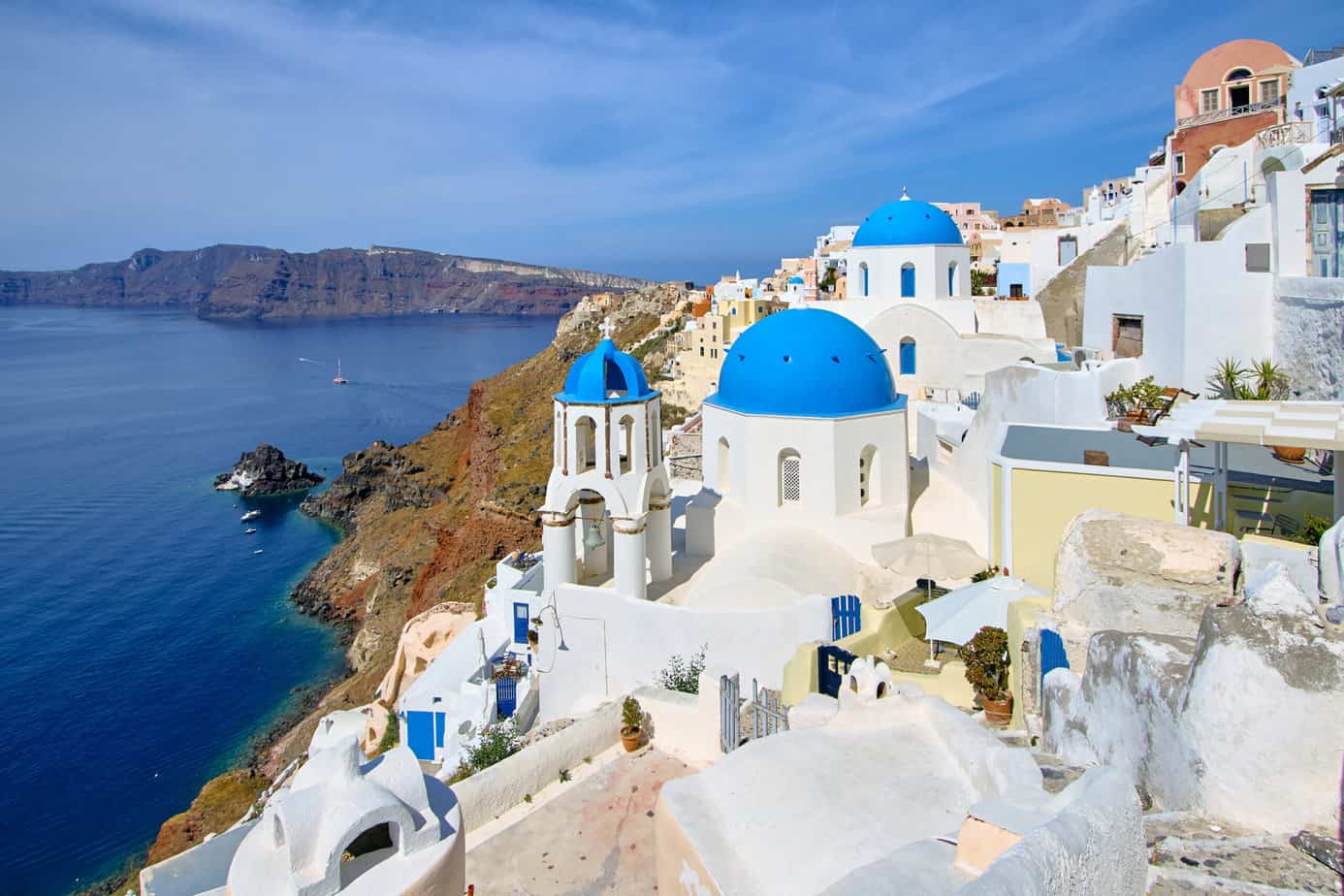
Santorini (Cyclades)
This is the most romantic Greek island I’ve seen and one of the most romantic spots on earth. Snow-white architecture capped by turquoise domes and windowsills spilling down cliffs to the turquoise Aegean Sea. The whole island looks like a giant Greek flag.
After my trip here, I vowed I’d return with a woman and never did. Skopelos won me over.
While Skopelos remains under the tourism radar, Santorini is over the top. There is a reason it gets 2 million visitors a year, the most of any Greek island. It has spectacular scenery, from the beautiful beaches to the quaint mountain villages.
I rented a moped and rode up to the village of Oia in the north, stopping in even smaller villages along the road for a Greek salad and a souvlaki. Most days I laid on the beach until sunset when everyone gathers on the sand and watches one of the best sunsets in Europe. Then we’d climb to the main town of Fira for dinner at an outdoor taverna with a great view of the sea.
The lone drawback, besides the cruise ships, the sand is volcanic and black. Walk on it barefoot at your own risk.

Skiathos (Sporades)
Seven years ago, Marina talked me into taking her here for her first time since 1986. We’ve been coming back to the Sporades, except for the Covid years, ever since. Skiathos is an easy reach from Rome. It’s a two-hour flight to Athens and then a 90-minute flight to Skiathos (which features one of the scariest airport landings in the world). We leave Rome at 6:30 a.m. and are poolside in Skiathos at 9 a.m.
Skiathos is only 50 square miles but has 65 beaches, all reachable by buses that cruise the sand-lined southern end of the island every 15 minutes. The golden sand beaches are lined with pine trees and all feature a restaurant and bar.
The beaches here get really crowded. Skiathos is definitely on the Greek tourist path. But we found solitude on Kolios beach, which is down a trail from the main road and is on a half-moon bay 400 meters long. It has fewer lanais chairs but also fewer tourists.
Skiathos Town has a charming harbor where you can take excursions all over the Sporades. Grab a coffee at The View, a cafe with comfortable chairs at the far end of the harbor. You won’t miss Papadiamanti, the pedestrian street that’s 700 meters of souvenir shops, restaurants, bars and boutiques.
Get off it and wander around the narrow alleys where you can see locals chatting on the sun-splashed streets or eating a gyro in one of the many little restaurants. Our favorite dining spot is Bakaliko, a romantic spot over the water and we highly recommend the Poseidon Villas hotel with a huge pool over Skiathos Town.
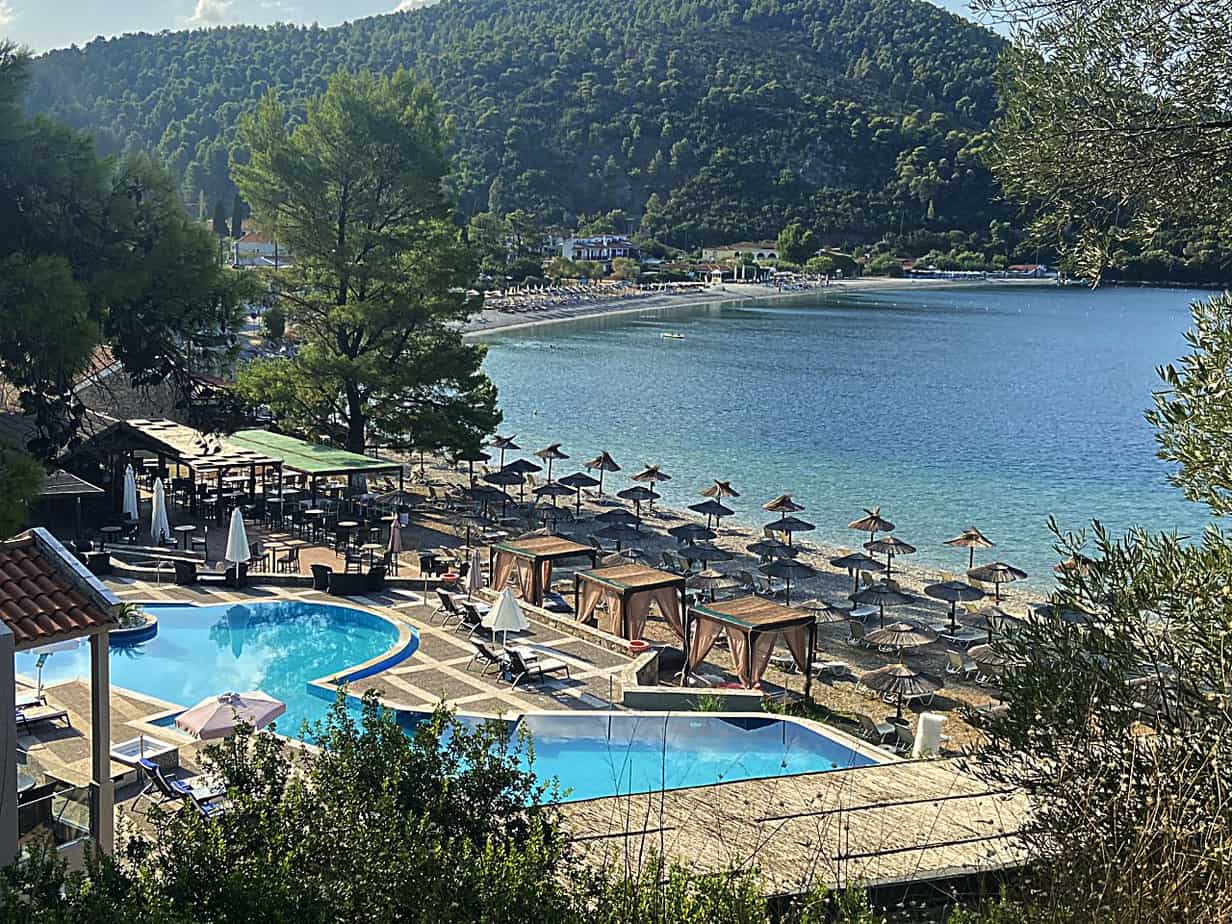
Skopelos (Sporades)
People confuse Skopelos and Skiathos but they only share proximity. Skopelos has no airport. It’s a 40-minute hydroplane ride from Skiathos and has a completely different atmosphere. We came here on a day trip from Skiathos and made it our annual August destination.
It’s only 37 square miles but has 360 churches and 18 beaches. It’s a nature lover’s paradise. It’s 80 percent forest, making it the greenest island in Greece. The Greek government has strict rules against deforestation.
Take a taxi up from the port in Skopelos Town and the forest thickens the higher you climb.
We stay in Panormos, a village of only 50 people on the west end of the island. The town is ringed by a sandy beach 100 meters long across the two-lane road and behind it is a forest towering up to 400 feet.
We have a set routine. We go to the beach in the early morning, lay in the lanais chairs until crowds begin picking up about noon. We go across the street to one of the dive tavernas for a fresh Greek salad and souvlaki and return to our room for a nap. We shower and dress then go to one of the many restaurants along the beach for an ouzo while watching the sunset and deciding at which of the dozen or so restaurants we’ll eat fresh seafood. We lean toward Yoannis for the view as well.
Our base this week again will be the Panormos Beach Hotel across the street from the beach with a big swimming pool backed by a bar where ouzo flows all night. The most popular beach is about a 20-minute walk. Kastani beach was the site of the famous dancing scene in “Mamma Mia!” which was filmed on Skopelos and was without question the worst movie in the history of cinema.
Skopelos, I’ll forgive you.

Tsougrias (Sporades)
Think Panormos is small? The island of Tsougrias has a population of … zero. It has no regular inhabitants. All there is a beach, lounge chairs and a bar. That’s it. All there is to do is lay on the beach, read and drink.
The ideal vacation.
Tsougrias is only four miles from Skiathos and a small boat took Marina and me there one morning for the perfect day trip. The boat ride took 10 minutes and dropped us off at a beautiful secluded beach of gold sand. Tsougrias is a protected natural habitat surrounded by pine forest.
It has so few tourists, the water is among the bluest I’ve seen in Greece. The shade changes as I walked through the sea 100 meters and it was still only up to my neck.
We ended the day at the bar with the sand floor and ate roast chicken on spits with ice-cold beer, waiting for the little boat to take us back to what Greece considers civilization. As the little turquoise-and-white surfboard-shaped sign I bought in Skiathos and hangs on my wall in Rome reads, “To travel is to live.”


August 23, 2023 @ 4:46 pm
John, Aren’t there fires on some of these islands? Saw the news report but don’t remember where.
September 7, 2023 @ 3:51 pm
The fires are in northeast Greece on the mainland. Athenians told me they could see fires off in the distance. They could be on islands or on the mainland but the 39 people who’ve died are all in the northeast. Skopelos is halfway up the Aegean and the air was pretty clear.